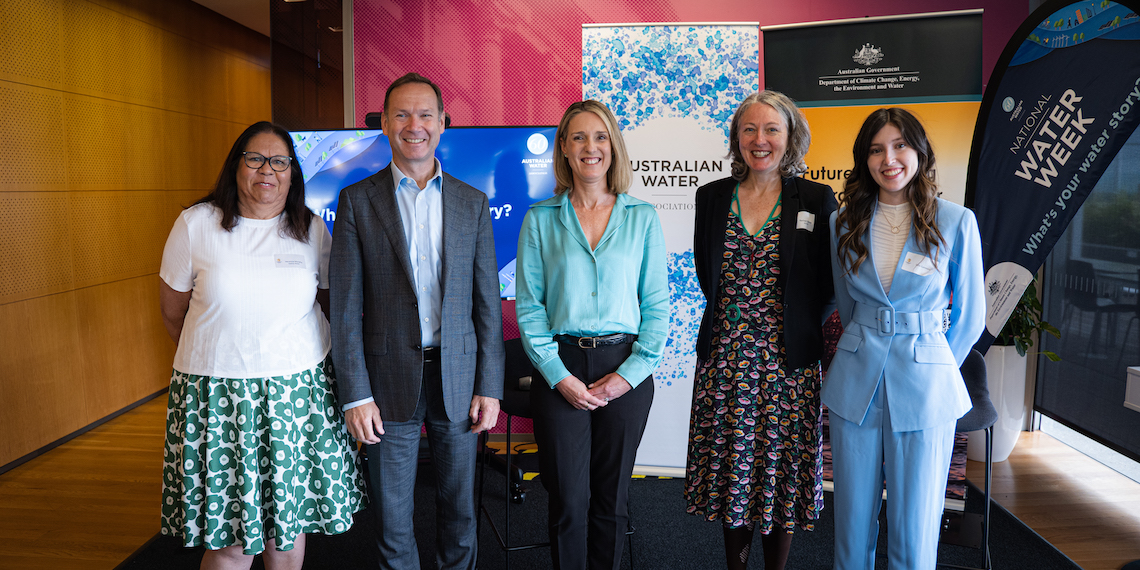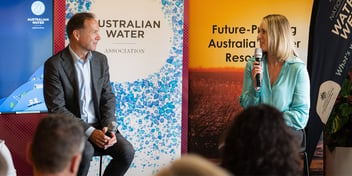Raising water’s profile: reflecting on value, engaging with community

Deep levels of community engagement are a necessity when it comes to meeting the challenges facing water, and National Water Week continues to provide an opportunity to raise community awareness of the value of our most precious resource.
Hosted by the Australian Water Association, National Water Week (NWW) was held last week, promoting the value of water across Australia, and inspiring individuals, educators, communities and organisations to raise community awareness and understanding of water-related issues.
With AWA celebrating its 60th anniversary, this year’s NWW theme – Our Water Stories – encouraged all Australians to reflect on their relationship with water and share their experiences.
Hosted at Sydney Water, the NWW launch included Acknowledgement of Country delivered by Sydney Water Indigenous Inclusion Specialist Veronica Murphy, and presentations from Sydney Water Managing Director Roch Cheroux, the Department of Climate Change, Energy, the Environment and Water's (DCCEEW) Head of the Water Reform Taskforce Rachel Connell, and 2022 winner of the Australian Stockholm Junior Water Prize, Julia Cummins.
Opening the event, AWA Chief Executive Corinne Cheeseman said this year’s NWW theme is all about taking the time to reflect on just how important water is to us all.
"’Our Water Stories' recognises the importance water plays in our lives. Water is life, and we can sometimes take it for granted; water is fundamental to our health and wellbeing and thriving communities, from drinking to cleaning with it to swimming in it,” she said.
“As AWA celebrates its 60th anniversary and reflects on our six decades of working with our members to manage extreme events such as droughts and floods, we continue to consider and adapt our stories to these challenges in the face of climate change and its increasing uncertainty."
Cheeseman said the water sector is starting to see communities talk more about water, particularly in times of extreme weather, providing a big opportunity to engage more with them on potential solutions to upcoming challenges.
“I really feel that there is greater awareness in our communities, which brings with it a great opportunity for us to take forward some new solutions,” she said.
“And to communicate the contribution that we make as water professionals, water organisations and governments to solve some of the challenges we have coming up ahead.”
Working with communities
Sydney Water Managing Directer Roch Cheroux spoke to launch attendees about the important role that First Nations people and broader communities play in helping to shape conversations and innovations.
“For about 65,000 years, the Aboriginal people in Sydney have managed water extremely well. They have sustained their communities on the water resources existing in the area. There are many things we can learn from Indigenous peoples about how they have managed water,” he said.
“Thinking about our impact on the environment and how we use water in terms of volume is absolutely critical. There are opportunities to do things differently in the future. We need to be thinking about these different solutions now.
“Communities are absolutely critical in what we do. We are not here to impose what we think is the right way forward, we are here to discuss ideas with the community, understand their needs and implement the solutions that are best to deliver what the community is expecting from us – and that includes Aboriginal people.”
Cheroux underlined the importance of ensuring a very high level of engagement with communities to ensure solutions to water management challenges are informed and effective.
“If you go back 50 years, water engineers decided what was good for the community. But that approach is simply not possible anymore. We really need to have a very high level of engagement with the community now,” he said.
“National Water Week comes back around every year, but water is in our lives everyday, every minute and every second.
“It’s important for us to take this week every year to think about how important water is in our life, and what we as a water industry can do to contribute not only to raising the profile of water, but also providing a better tomorrow.”
Story of reform
DCCEEW Head of the Water Reform Taskforce Rachel Connell shared her own water story at the launch, but also the story of Australia’s current pathway to water reform in the face of climate change.
“Climate really is our big challenge at the moment. In terms of water in Australia, we're highly regarded internationally – the Australian water management story is one of success. However, we know the impacts of a changing climate are going to challenge this,” she said.
“Good seasonal rainfall over the past couple of years has presented both opportunities and challenges. For the most part, our water storages are now full across the country. Rainfall has replenished thirsty wetlands, boosting fish, frog and bird populations and helping revitalise our river ecology across the country, particularly in the basin.
“But coming into our third La Niña, we're also seeing terrible consequences, with floods impacting homes and businesses, and tragically, in some cases, costing lives.
“We know that, as long as we live in Australia, the dry years will follow the wet. The impacts of climate have been predicted, and we are already living through those predictions.”
Connell said the water stories arising from these events are devastating for individuals, families, businesses, and communities, but also for the health of rivers and the ecological communities that depend on them.
“We need to be better prepared for the future. We need to make sure we can improve water security for all while maintaining our healthy rivers. The Australian Government has mapped out quite an ambitious reform agenda nationally and across the Basin,” she said.
“We have started working in earnest with states and territories on a new national water reform framework.
“And this framework, if it does its job, should mean that our water stories in 10 or 20 years time are framed by the fact that state water resource managers, urban and local water utilities, flood agencies, the [Murray-Darling Basin Authority], and our Commonwealth Environmental Water Holder, all have the predictive planning and management tools to deal with a changing climate.
“It will mean that First Nations people can tell stories about adequate potable drinking water and how they are managing water for cultural outcomes.”
“This work is going to be critical to securing the future of Australia's water resources in a rapidly changing climate.”
Take a look at some of the water stories shared last as part of National Water Week.



